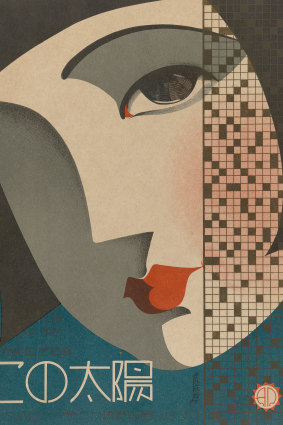
Imai Hisamaro, artwork This Sun (colour offset lithograph, 1930), for a magazine cover.
Between two of Japan’s greatest calamities, Tokyo briefly emerged as one of the world’s great cosmopolitan centres, a bustling metropolis that played backdrop to what we tend to think of as European scenes of that era: cafes playing swinging jazz, fashionable young things flaneuring in the evenings, women out in clubs, smoking and drinking.
But in the years after the 1923 Kanto earthquake that destroyed the city, and before the war years that ended in the 1945 Allied bombing, Tokyo flourished as an urbane modernist capital. As in Europe, these were years of social and technological change, but in Japan traditional culture intersected as never before with modern European culture, resulting in a uniquely Asian spin on Art Deco and modernism.
This short-lived cultural movement is the subject of the NGV’s new exhibition, Japanese Modernism, the result of five years of collecting by Wayne Crothers, the gallery’s Senior Curator, Asian Art, and his team.
“Asian art from the early 20th century is not really presented in any of the Australian institutions, and this is an exciting start to begin addressing that,” says Crothers.
He and his team have been researching, following leads and acquiring artworks, ephemera and decorative arts from the era, from dealers, collectors, donors and others. Most of it has never before been exhibited in Australia.
While the European Art Nouveau and Art Deco movements were influenced by Japanese art and design after the country opened to international trade in the 1850s, in the 1920s the cultural amalgam was reversed, and Western design helped shape an all-new incarnation of Japanese fashion, design, art and architecture.
As Tokyo was rebuilt after the Kanto quake, department stores, coffee shops, dance halls, movie theatres and modern transportation catered to a new generation of urban pleasure-seekers.
“Tokyo and Osaka rivalled the great international modern cities across the world in the 1920s,” says Crothers, adding that Japan was at the time the most progressive of the Asian countries. “The aristocracy and the Imperial family were travelling in Europe ... and they took note of the expansion of the British, the French and the Belgians and went back to Japan and then expanded their influence in Asia.”
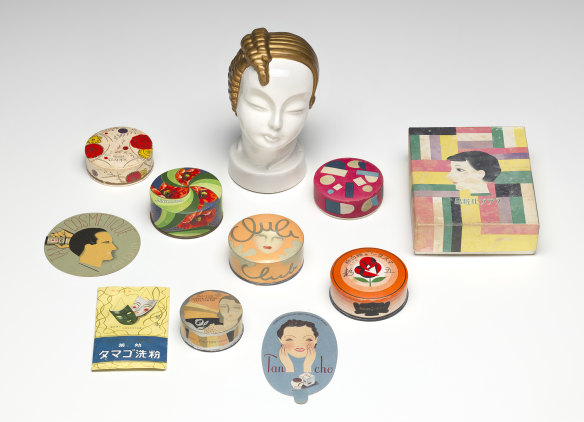
A selection of 1930s cosmetics from Japanese Modernism.
The economy boomed, and while it’s typically thought the 1960s heralded the beginning of Tokyo’s modern age, it actually blossomed 40 years earlier.
“It’s a neat little window ... that no one really recognises,” says Crothers. “In recent years, among art students especially in Japan, it’s become recognised, but outside it’s not really known.”
Most startling is the fact that the rise of department stores and leisure culture created new jobs – and in turn a new generation of socially liberated women who, until then, had traditionally stayed at home with the family. Suddenly there was a generation of liberated women.
Retailers such as Mitsukoshi – which had existed as kimono retailers since the 17th century – grew into multi-level department stores, opening up jobs for women. At the same time, the country’s first subway network was built, and domestic tourism boomed.
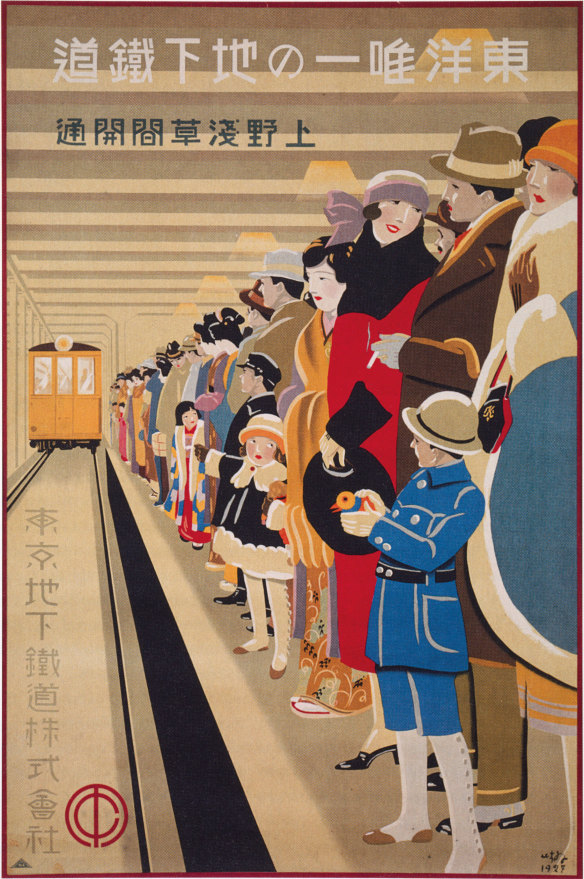
The first subway in the East, 1927 by Hisui Sugiura.Credit: Estate of Hisui Sugiura
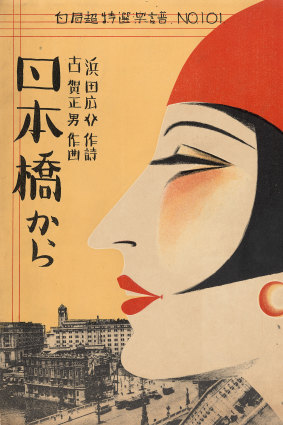
A popular music score from the 1930s.Credit: NGV
“All of a sudden women could come in from the countryside to the city, earn their own living – small though it was – rent their own little apartments, and the most important thing was, they could buy the things they wanted to buy, not the dowdy fashion their parents wanted them to wear,” says Crothers.
With shades of the Western flapper culture, bobbed hairstyles became popular, as did Western cosmetics and grooming products, and imported music. These independent women came to symbolise the movement, being dubbed “Moga”, a contraction of “modern girl (“modan gaaru" in Japanese), and their male counterparts were the “mobo” ("modern boy").
“The ‘moga’ were independent, earned a salary, lived by themselves, they could drink, they could smoke, they could stay out late at night – as long as they turned up dutifully to their job the next morning, they could do what they liked,” says Crothers. “And they weren’t only participating in the economy as workers but as consumers – they went out and bought these crazy fashions – both Western and with a nostalgia for Japanese tradition. They were still interested in buying kimonos, but the designs went really wild.”
The exhibition features several kimonos, both men’s and women’s, adorned with cutting-edge motifs which might make their mothers blush, and matched accessories you could buy to complete the ensemble.
But women weren’t only working in retail; this liberated generation (who even embraced divorce!) included artists and designers, and Crothers has acquired rare artworks by female artists of the era.
“Even though some of them, like Taniguchi Fumie – who was the quintessential ‘moga’ with the short hair and the kiss curls – became quite noted, it was still a very male-dominated world, and most of the artworks have been lost and their careers have become sort of lost as well.”
Taniguchi Fumie’s 1935 six-screen work Women Preparing to Go Out uses the traditional form of large-format painting on silk screens, but depicts contemporary women wearing Western clothes and make-up.
Elsewhere in the exhibition of almost 200 pieces, the period’s familiar – yet distinctively Japanese – graphic design features in detailed travel maps, magazines, sheet music scores and posters. These include the advertising poster for Japan’s first subway system, which opened in 1927, regarded as the most iconic work of 20th-century Japanese graphic design. Created by design pioneer Hisui Sugiura, The First Subway in the East is based on the style of French Art Deco posters, using the diminishing point of perspective (a distinctive feature of Japanese ukiyo-e woodblock printing), and shows a new subway train arriving at a platform crowded with both moga and mobo as well as traditionally clad commuters.
“It’s a beautiful, famous work that has a mix of women in traditional costume, then hyper-fashionable men and women smoking ciggies and smiling in the foreground; all these messages about arrival, and new things in the foreground,” says Crothers. “I thought it would be impossible to get – these weren’t printed as artworks to last, but as street posters.”
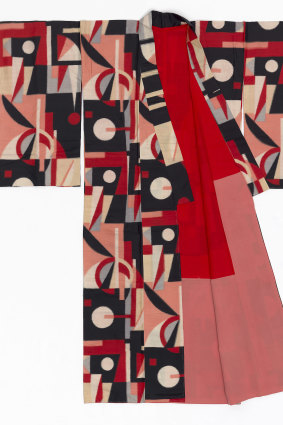
A woman’s kimono with geometric Modernist design and accessories. Credit: NGV
Two years after he put feelers out, a dealer called to say he’d found a copy. “I nearly fell off my chair,” says Crothers.
As well as other posters commemorating the Mitsukoshi department store opening, all mogas in modern fashion and dramatic Modernist lines, and the 1935 Yokohama International Exposition, there’s a selection of printed sheet music scores (film soundtracks were popular, scored for bohemian instruments such as the ukulele and harmonica), copies of weekly magazine Asahi Weekly, which still runs today, and psychedelic-looking kids’ magazines which Crothers says were a “great outlet for the progressive, avant-garde illustrators of the day”.
In the selection of decorative arts, including cut glassware and lacquerware, more traditional motifs are blended with the modern lines and shapes of Art Deco. A rare series of woodblock prints commemorating the Kanto earthquake reinterprets traditional Ukiyo-e techniques, which fell out of fashion after the invention of photography, with a modern view.
It’s a fascinating view into an overlooked window of design that came to an abrupt halt with World War II.
“And these modern booms tend to gradually lead toward national ambition, and expansion, and that’s really this sort of … fatal road that Japan followed all the way to the war – and then their ultimate destruction, which put them back for 30 years,” says Crothers.
As well as offering a greater understanding of the modernisation of Asia, the acquired works will form part of the gallery’s Asian art archive, which Crothers sees as an important cultural resource that will only become more important.
“It’s similar to (Hokusai’s) The Great Wave, which the gallery purchased in 1909, and people were outraged at the price we paid for it,” he says. “And now every museum in the world wants a Great Wave! There’s only a handful in existence – and you have to pay up to a million bucks.”
Japanese Modernism, NGV International, February 28-October 20. www.ngv.vic.gov.au